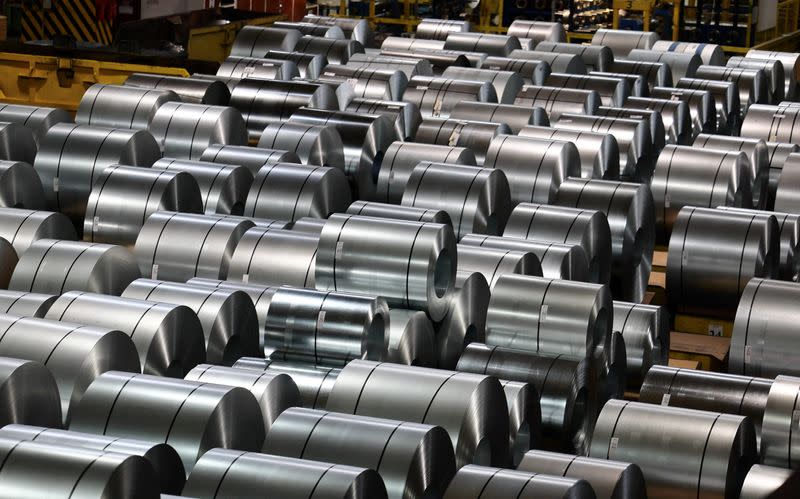Fears of German 'de-industrialisation' may be overblown - for now

By Maria Martinez
BERLIN (Reuters) - High energy costs, weak global demand, a disruptive shift towards net-zero economies, and growing competition from China are raising existential questions for Germany's economic model.
CEOs and business lobbies say its historically strong industrial base is close to cracking, a "de-industrialisation" risk often accompanied by calls for government support.
But how real is this risk? Here are some key data and how close watchers of the German economy interpret them.
SHRINKING OUTPUT
Monthly industrial production data give the most obvious snapshots of how the sector is doing, and they show a clear decline since the end of 2017, exacerbated by the COVID-19 pandemic and now the Ukraine war.
"In Germany, it is relatively clear that industrial production will remain lower than before the (energy) price increases with the war in Ukraine," said Torsten Schmidt, economist at the Leibniz Institute for Economic Research RWI.
Industrial production refers to the output of the manufacturing, energy and construction sectors. The indicator is an index based on a reference period and shows changes in production volumes.
Although this indicator gives the most up-to-date view of where industry is heading, economists use other measures to get a broader sense of the trend.
VALUE ADDED HOLDS UP
One such is how much value is added to the economy by manufacturing - and that has fallen only slightly.
"Germany is indeed producing fewer cars, producing fewer other things and exporting less of it," Berenberg's chief economist Holger Schmieding said. "However, if you look at how much German companies actually earn by doing so, the value added per car or per machine has gone up."
That, Schmieding suggests, shows that companies are moving up the quality ladder. Another factor is that, with supply chains stretched by the trade turbulence of the past five years, companies are sourcing more inputs at home.
At 20%, manufacturing's share of Germany's total output is well above the 16% average in the European Union and, with the exception of Japan, much higher than in the world's other major economies.
"The industry rate is largely stable, constant at a very, very high level," said Ifo Institute economist Timo Wollmershaeuser. "Nothing has happened in the last few years that worries me."
JOBS DECLINE, BUT FROM A HIGH BASE
Some economists define deindustrialisation as a significant loss of workers in the industrial sector.
Although the data show a long-term trend downwards, manufacturing in Germany still accounts for 27% of total employment, down from 32% 20 years ago, International Labour Organisation figures show. This remains a far larger share than in the other major euro zone economies with the exception of Italy.
While arguing the fall was not sharp enough to suggest deindustrialisation, Klaus-Juergen Gern at the Kiel Institute for the World Economy acknowledged it was a trend "in which production will migrate or has migrated out of Germany on a permanent basis".
Ifo's Wollmershaeuser noted that labour shortages were encouraging automation that in turn led to lower employment.
"Basically all that means is that employment can fall but value creation can keep increasing," he said.
POLITICS IS A TURN-OFF
Overall foreign direct investment inflows into Germany saw a 12% drop in projects last year, a survey by professional services group EY found, outstripping the rate of decline in F.DI into Europe as a whole.
Likewise, a study by the German Economic Institute IW shows foreign companies only invested around 22 billion euros ($24 billion) in Germany in 2023, the lowest level in 10 years.
"Politics makes it anything but attractive for companies to invest in Germany," IW economist Christian Rusche said of the industrial policy disputes within Chancellor Olaf Stolz's coalition of social democrats, ecologist greens and pro-business liberals.
The lack of skilled labour also puts the brakes on investment decisions. Official German estimates suggest the country will have 7 million fewer skilled workers by 2035, out of a labour force of around 46 million.
THE WIDER CHALLENGE
While the data show a downward trend in manufacturing from a much higher base than in other economies, economists agree that concerns about deindustrialisation are - for now - overstated.
Gern at the Kiel Institute says the country is following a trend typical of mature economies of reducing the share of industrial production in total output.
"We can't speak about deindustrialisation yet, but there are structural challenges," he said, noting the 20% drop in production in energy-intensive sectors in 2023.
Both Economy Minister Robert Habeck and Finance Minister Christian Lindner acknowledge that Germany faces structural problems as a business location, however their proposals for how to tackle the problems in the sector differ.
While the ecologist Habeck proposes subsidies to promote investments in green technologies, economic liberal Lindner says the country needs less bureaucracy.
($1 = 0.9308 euros)
(Reporting by Maria Martinez; Editing by Mark John and Hugh Lawson)

